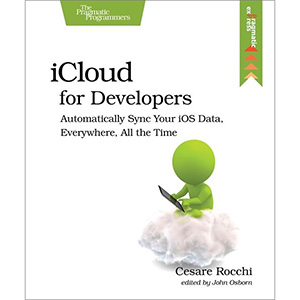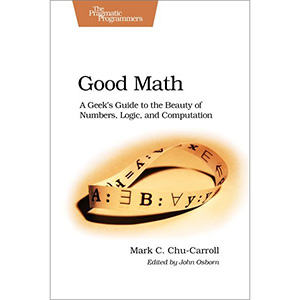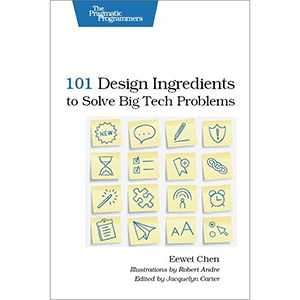Wow! eBook: Test iOS Apps with UI Automation - 4 new eBooks |  |
- Test iOS Apps with UI Automation
- iCloud for Developers
- Good Math
- 101 Design Ingredients to Solve Big Tech Problems
| Test iOS Apps with UI Automation Posted: 23 Aug 2013 08:06 AM PDT
Book DescriptionIf you're an iOS developer or QA professional tapping through an app to reproduce bugs or performance issues you thought were solved two releases ago, then this is your book. Learn how to script the user interface, assert correct behavior, stub external dependencies, reproduce performance problems, organize test code for the long haul, and automate the whole process so the machine does the work. You'll walk through a comprehensive strategy with techniques using Apple's tools that you can apply to your own apps. Automated user interface testing is an important part of a comprehensive testing strategy for iOS applications. By scrutinizing your app through the eyes and actions of the user, you raise confidence that features are wired up right and behave as you expect. Through this book you'll learn how to do full-stack testing of your iOS apps in both the simulator and on the device with Apple's built-in tools. You'll write behavioral tests in UI Automation that help protect against regressions. You'll write scripts to repeat steps in Instruments to reproduce performance bugs. With a little ingenuity, you'll build a workflow that gives the feedback you need. Grow a test suite by working with a real application that uses Core Data and network requests. Learn how to describe expected behavior in test scripts, launch the app in a specific state, and stub external dependencies for completely isolated and repeatable tests. Along the way, you'll practice how to organize your test code and run it hands-free from the command line. By the end, you'll have the tools and habits you need to tackle the unique testing problems you'll face while building best-of-breed native iOS apps for your users. What You Need Table of Contents Book Details
Related Books
The post Test iOS Apps with UI Automation appeared first on Wow! eBook. |
| Posted: 23 Aug 2013 08:01 AM PDT
Book DescriptionGet up-to-date fast on the techniques you need get your applications iCloud-ready. With Apple's iCloud servers now available to developers, there's every reason to make synchronization a core feature of your product. You'll learn how to iCloud-enable the data formats you're most likely to use in an iOS application: key-value data, document-based data, and relational data. Using a simple grocery list application as an example, you'll find out how to configure any application to make the most of iCloud's capabilities. Your app's users want their application data to be in sync as they switch from one device to another. Guided by iOS expert Cesare Rocchi, you'll start by learning how to configure an app and its resources for iCloud. Then, after a quick introduction to iCloud-supported data types, you'll work on using the simplest: key-value data. Next, you'll find out how to get your document-based data (including media files), and even relational data working with iCloud. As you learn each new technique, you'll use it to synchronize yet another module of the book's sample app, Grocery, a simple shopping list that can be shared between two or more devices. You'll learn how to handle the kinds of conflicts likely to occur when you build apps that keep themselves in sync across phones and tablets, as well as how to deal with the notifications used by iCloud to broadcast changes as they occur. As devices proliferate, synchronization is more important than ever. When you finish this book, you'll know how to make it a part of your own applications. What You Need Table of Contents Book Details
Related Books
The post iCloud for Developers appeared first on Wow! eBook. |
| Posted: 23 Aug 2013 07:54 AM PDT
Book DescriptionMathematics is beautiful—and it can be fun and exciting as well as practical. Good Math is your guide to some of the most intriguing topics from two thousand years of mathematics: from Egyptian fractions to Turing machines; from the real meaning of numbers to proof trees, group symmetry, and mechanical computation. If you've ever wondered what lay beyond the proofs you struggled to complete in high school geometry, or what limits the capabilities of the computer on your desk, this is the book for you. Why do Roman numerals persist? How do we know that some infinities are larger than others? And how can we know for certain a program will ever finish? In this fast-paced tour of modern and not-so-modern math, computer scientist Mark Chu-Carroll explores some of the greatest breakthroughs and disappointments of more than two thousand years of mathematical thought. There is joy and beauty in mathematics, and in more than two dozen essays drawn from his popular "Good Math" blog, you'll find concepts, proofs, and examples that are often surprising, counterintuitive, or just plain weird. Mark begins his journey with the basics of numbers, with an entertaining trip through the integers and the natural, rational, irrational, and transcendental numbers. The voyage continues with a look at some of the oddest numbers in mathematics, including zero, the golden ratio, imaginary numbers, Roman numerals, and Egyptian and continuing fractions. After a deep dive into modern logic, including an introduction to linear logic and the logic-savvy Prolog language, the trip concludes with a tour of modern set theory and the advances and paradoxes of modern mechanical computing. If your high school or college math courses left you grasping for the inner meaning behind the numbers, Mark's book will both entertain and enlighten you. What You Need Table of Contents Part II: Funny Numbers Part IV: Logic Part V: Sets Part VI: Mechanical Math Book Details
Related Books
The post Good Math appeared first on Wow! eBook. |
| 101 Design Ingredients to Solve Big Tech Problems Posted: 23 Aug 2013 07:49 AM PDT
Book DescriptionTough technology and business challenges face you at every stage of a project. The one-page ingredients in 101 Design Ingredients show you how to solve problems using practical examples you can apply right away. Case studies explain how leading companies combined these ingredients into their own unique recipes to catapult their businesses, and how you can, too. One page, one ingredient. 101 reasons to become more successful at solving those big technology problems. 101 Design Ingredients will help your technology team identify problems, share responsibilities, and work better together. In parts 1 through 4, you'll find 101 problem-solving ingredients grouped into project stages, to help you apply the right ingredient at the right time. Start at any point and page through the humorously illustrated ingredients until you find one that matches your needs best. The ingredients cover the spectrum your business needs to be successful, with tips on team-building, creating a business model, product launch, productivity, and much more. Each ingredient includes three practical suggestions to get you started right away. In part 5, you'll see examples of how companies can blend some of the ingredients used in this book to solve specific business requirements for investment, innovation, leadership, and more. Each recipe shows how a company fine-tuned six of the ingredients to build their own unique solution. You'll learn how to mix and match ingredients to create your own recipes for success, tailored to your company's needs. The ingredients and recipes in this book can be applied by beginners starting out on their first technology project, as well as seasoned professionals who have been tackling the same big problems for years and need a fresh new approach to problem solving. Table of Contents Book Details
Related Books
The post 101 Design Ingredients to Solve Big Tech Problems appeared first on Wow! eBook. |
| You are subscribed to email updates from Wow! eBook To stop receiving these emails, you may unsubscribe now. | Email delivery powered by Google |
| Google Inc., 20 West Kinzie, Chicago IL USA 60610 | |




Tidak ada komentar:
Posting Komentar